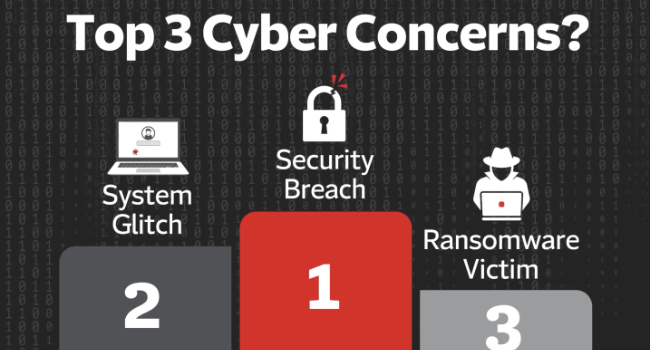
Travelers Risk Index Shows Cyber Threats Remain Top Overall Business Concern
The Travelers Companies, Inc. recently released its 2022 Travelers Risk Index results, and for the third time in four years, the survey found that cyber threats were the top overall concern for business decision makers. Of the 1,200 survey participants, more feel that today’s business environment is riskier compared to a year ago, and more than half (57%) think a future cyber attack on their company or organization is inevitable.
Cyber threats again were the leading concern, but other issues were close behind, a change from 2021 when cyber held the top spot by 6 percentage points. This year, 59% of survey respondents said that they worry some or a great deal about cyber threats, followed closely by broad economic uncertainty (57%), fluctuations in oil and energy costs (56%), the ability to attract and retain talent (56%), and medical cost inflation (55%). Big jumps were seen this year relating to concerns in oil and energy costs (a 16-point increase, up from 40%) and supply chain risks (54%, up from 43%), a nod to current events and the serious obstacles businesses and individuals are facing.
“Cyber attacks can shut down a company for a long period of time or even put it out of business, and it’s imperative that companies have a plan in place to mitigate any associated operational and financial disruptions,” said Tim Francis, Enterprise Cyber Lead at Travelers. “Effective measures that have proven to reduce the risk of becoming a cyber victim are available, but based on these survey results, not enough companies are taking action. It’s never too late, and these steps can help businesses avoid a devastating cyber event.”
Overconfidence in navigating the evolving cyber landscape is causing a false sense of security, with 93% of respondents stating that they were confident their company had implemented best practices to prevent or mitigate a cyber event. But when asked whether their company had taken specific prevention measures, the majority had not: 64% don’t use endpoint detection and response, 59% haven’t conducted a cyber assessment for vendors, and 53% don’t have an incident response plan.
Even multifactor authentication (MFA) has been slow to catch on. According to this year’s Travelers Risk Index, 90% of survey respondents said they were familiar with MFA, yet only 52% said their company had implemented the practice for remote access. This, despite Microsoft stating that 99.9% of account compromise attacks are blocked by adding the extra security measure of MFA to verify a computer user’s identity, and Arete stating that 94% of ransomware victims weren’t using MFA.
Other important survey findings relating to cyber include:
- The cyber-specific concerns that stayed in the top two spots are: suffering a security breach or someone hacking into a business computer system (57% say they worry some or a great deal) and a system glitch causing a company’s computers to go down (55%). Becoming a cyber extortion/ransomware victim moved from eighth position to third this year at 54%.
- For the seventh consecutive year, there was an increase in the percentage of survey participants who said their company had suffered a data breach or cyber event. This year, 26% said their company had been a cyber victim, with nearly half of those (49%) reporting that the event had happened within the past 12 months.
- Of those who said their company had suffered a data breach or cyber event, 71% have been a victim more than once.
- Nearly 75% of respondents said they believe having a cyber insurance policy is critical, but the percentage who said their company has purchased coverage was 59%, up only 3 points from 2021. Small businesses accounted for the largest increase of cyber policy purchasers, up from 30% to 38% this year.
Francis added, “Multiple cyber attacks might not be random – if you were vulnerable before and don’t take appropriate action as a result, you continue to be at risk. It’s important to take the prospect of a cyber attack seriously and to put your company in position to successfully manage a likely event.”